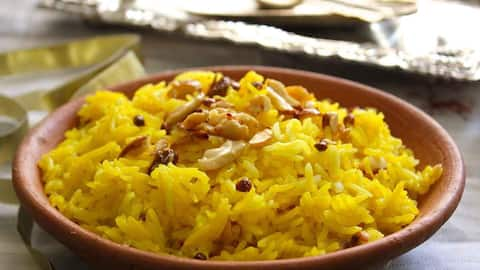Basant Panchami's signature dishes: A celebration in every bite
What's the story
Spring is in the air, and so is the aroma of saffron-spiced sweets and traditional feasts! Basant Panchami, the vibrant festival of knowledge, wisdom, and the color yellow, will be celebrated on Febuary 2, 2025. While it's a day to honor Goddess Saraswati, it's also a culinary carnival across India, showcasing dishes as diverse as the mustard fields in bloom. From sweet saffron rice to Bengali kooler chutney, let's dive into the flavors and traditions that define this springtime celebration.
Festival customs
Cultural significance and traditions of Basant Panchami
In Gujarat, the festival witnesses the exchange of garlands made from mango leaves. The signature color of Basant Panchami is yellow, representing the mustard fields in bloom in Punjab and Haryana. Foods are often colored with saffron and turmeric to honor both the deities and the season, making it a vibrant celebration across India.
Festival cuisine
Traditional dishes of Basant Panchami: Meethe chawal
Meethe chawal, aka zarda or kesariya rice, is another popular dish on Basant Panchami. This sweet delicacy uses long grain basmati rice and saffron for its yellow hue. The dish is further enriched with ghee, dry fruits, and nuts. Originating from Persia, meethe chawal has become a staple in northern India's celebration of the festival.
Bengali cuisine
Bengali delicacies: Kooler chutney and labra
In Bengal, kooler chutney, prepared from jujube berries grown in December, is a festive highlight. It is made after prayers to Goddess Saraswati on Saraswati Puja. Another traditional Bengali dish served during the festival is labra, a mixed vegetable preparation using seasonal vegetables like sweet potato and pumpkin. Flavored with panch phoron and bhaja masala, this dish adds to the culinary diversity of Basant Panchami celebrations.
Festival sweets
Boondi laddoo and tesu tea: Sweet treats of Basant Panchami
Another traditional dish associated with Basant Panchami is boondi laddoo, a sweet treat made from gram flour balls cooked in saffron syrup. Its orange color and taste embody the festival's traditions. Tesu tea, made from Palash flowers, marks the start of a countdown to Holi. The beverage serves as both a natural colorant for Holi and a medicinal aid, adding another layer to the festival's culinary traditions.
Festival offerings
Malpua and khichuri bhog: Traditional offerings of Basant Panchami
Malpua, a festive favorite in Bihar and Haryana, is another dish linked to Basant Panchami. These fried pancakes are soaked in sugar syrup and flavored with kewra water and cardamom. They are offered to Goddess Saraswati for blessings during the festival. Khichuri bhog, a Bengali rice dish made with Gobindobhog rice and sona moong daal, symbolizes simplicity and devotion during the celebrations, further enriching the culinary traditions of Basant Panchami.
